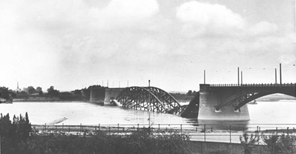The Nijmegen road bridge after it had been blown by Dutch Army Engineers on the morning of 10 May 1940.
The rail bridge was blown by the Dutch Army on the same morning.
The Nijmegen area was the target of the German XXVI Corps with 254th Infantry Division to north and 256th Infantry Division to south, with 9th Panzer Division behind. Operation Trojanischen Pferd, a cargo ship loaded with an infantry company had to take the bridge from 254th Infantry Division headed for the 2 bridges at Nijmegen over the Waal. This attempt at a “Trojan horse” failed as it did not arrive; this was to have attacked at dawn from barges moored nearby. No paratroops were used here.
German Invasion May 1940.
The Dutch armed forces mobilised in September 1939. It was hoped this would help deter invasion, as it did in 1914. If an attack did come, it was accepted that Dutch forces could not stop the inevitably stronger Germans. They could however slow any advance and, if the larger French and British forces were successful further south, there was a chance that any invasion would stall. This did not, of course, happen.
The Wehrmacht were aware that Dutch engineers had mined all key bridges within easy reach of the border, including the road and rail bridges at Nijmegen. As the River Waal was a formidable natural defence, a decision was made to capture these bridges intact by taking the sentries by surprise. A plan to use a civilian barge to tow a 100 man raiding party downstream the night before the invasion was abandoned due to the presence of a Dutch Navy gunboat upstream close to the border. Instead, a force from the armoured recce battalion Waffen-SS Vefgungs Division [motorbikes-troops], reinforced with armoured cars, were assigned the task of passing through Dutch defences south of the Waal as soon as hostilities commenced, drive the 6 km to Nijmegen at top speed and seize both bridges.
At dawn on 10 May 1940 German forces invaded the Netherlands at the same time as their attacks on France, Belgium and Luxembourg. The SS reconnaissance unit advanced to Nijmegen as planned, only to witness both bridges being blown as they arrived. Dutch forces south of the Waal soon withdrew westward to prepared positions along the Maas-Waal canal. Nijmegen was the first Netherlands city to fall and saw no more substantive fighting during the 1940 campaign.
By destroying the Nijmegen bridges, the Dutch Army not only prevented German forces south of the Waal from joining up with others further north, but also effectively blocked the river, denying this route to the invaders.
The Waal ferry, closed when the road bridge opened in 1936, recommenced shortly after the end of hostilities. Dredging under the north span of the road bridge allowed limited river traffic, while the fallen central arch was repaired. The road bridge was finally re-opened in 1943.
#
The Germans crossed the border east of Nijmegen at X-Zeit and tried to take both Waal Bridges. Operation Trojanischen Pferd, a cargo ship loaded with an infantry company had to take the bridge, failed and the German Vorausabteilung arrived too late: at 4.25 the first bridge was blown before their eyes, followed minutes later by the Railway Bridge.
#
The Nijmegen area was the target of XXVI corps with 254 ID to north and 256 ID to south, with 9 pz d behind. 254 ID formed 2 special forces of which group Nijmegen headed for the 2 bridges at Nijmegen over the Waal. An attempt by a “Trojan horse” failed as it did not arrive; this was to have attacked at dawn from barges moored nearby. No paratrops were used here.
A force from the armoured recce battalion of waffen ss vefgungs div, acting as corps troops, moved cross country over the Berg en Dal hills. They raced for the bridge from the south and arrived at 0445 Dutch time. The bridge had been blown 20 minutes earlier.
The main body of group Nijmegen advanced along the Kleve to Nijmegen road which led to a roundabout just south of the river Waal in Nijmegen. Dutch defenders were found along this road. The German infantry fought against these defences as the recce unit pushed through.
